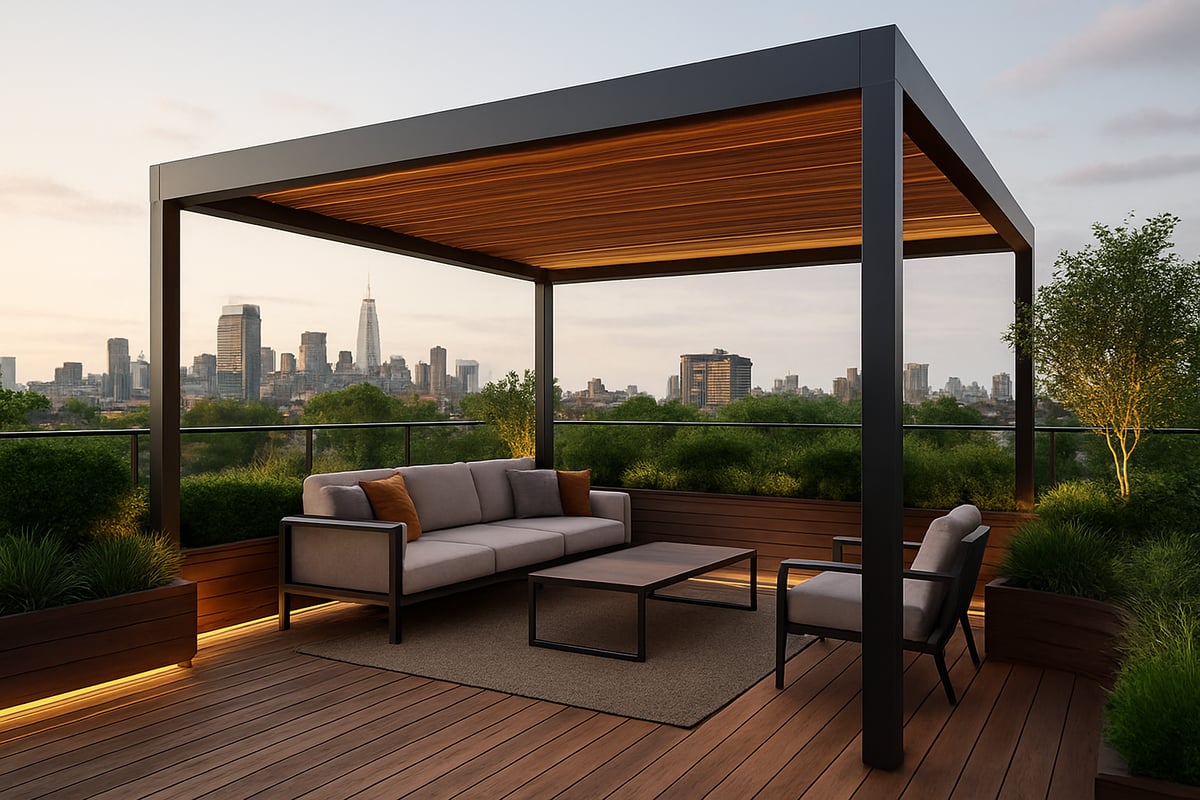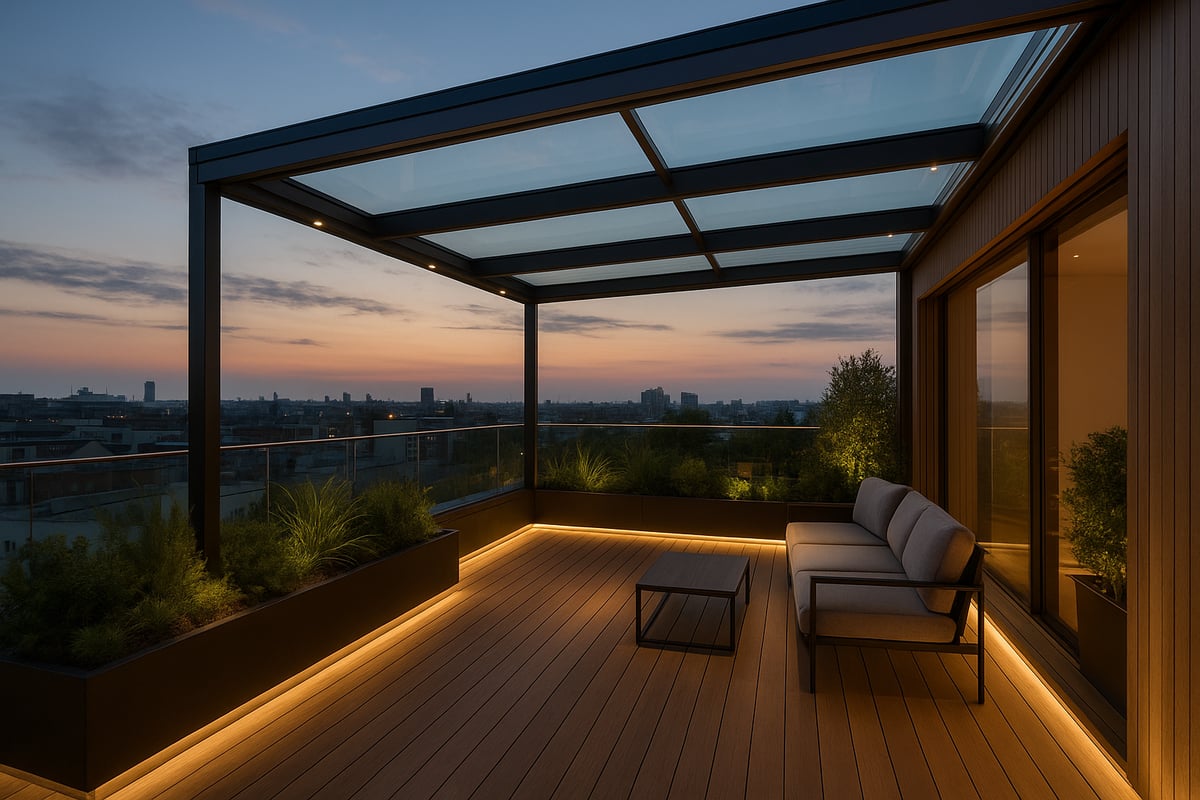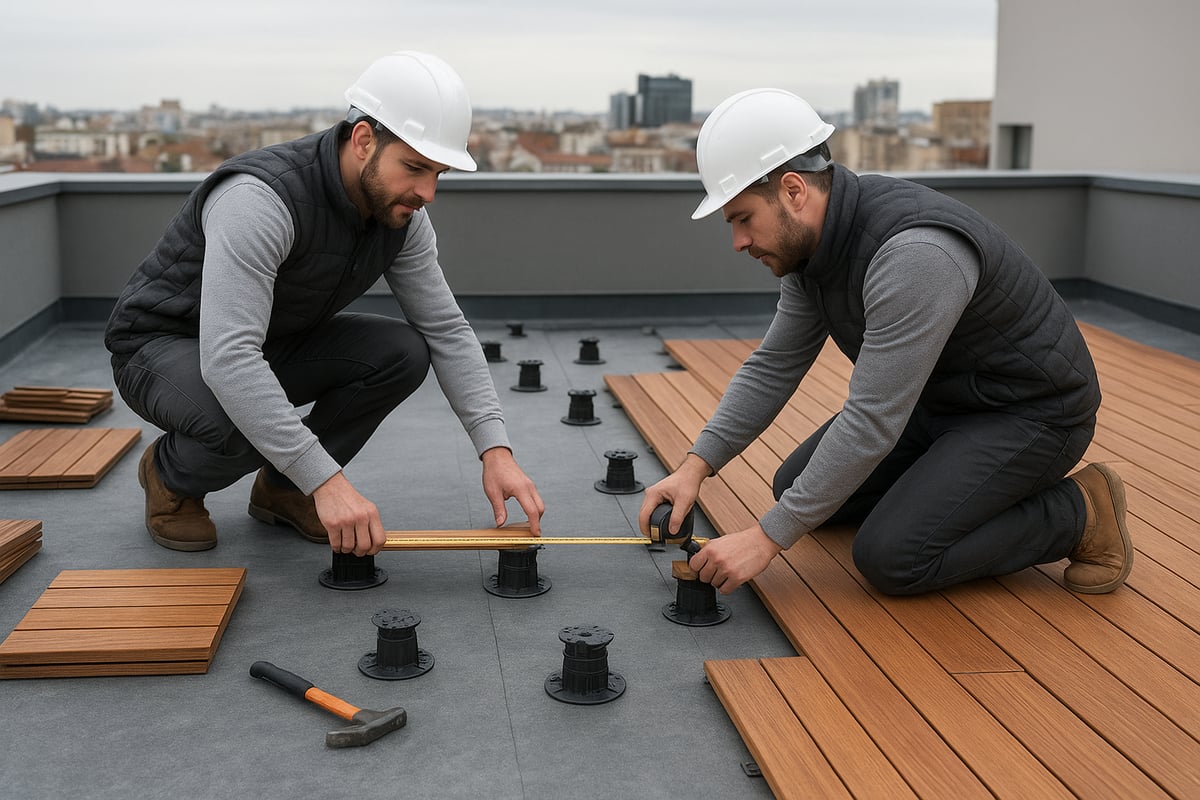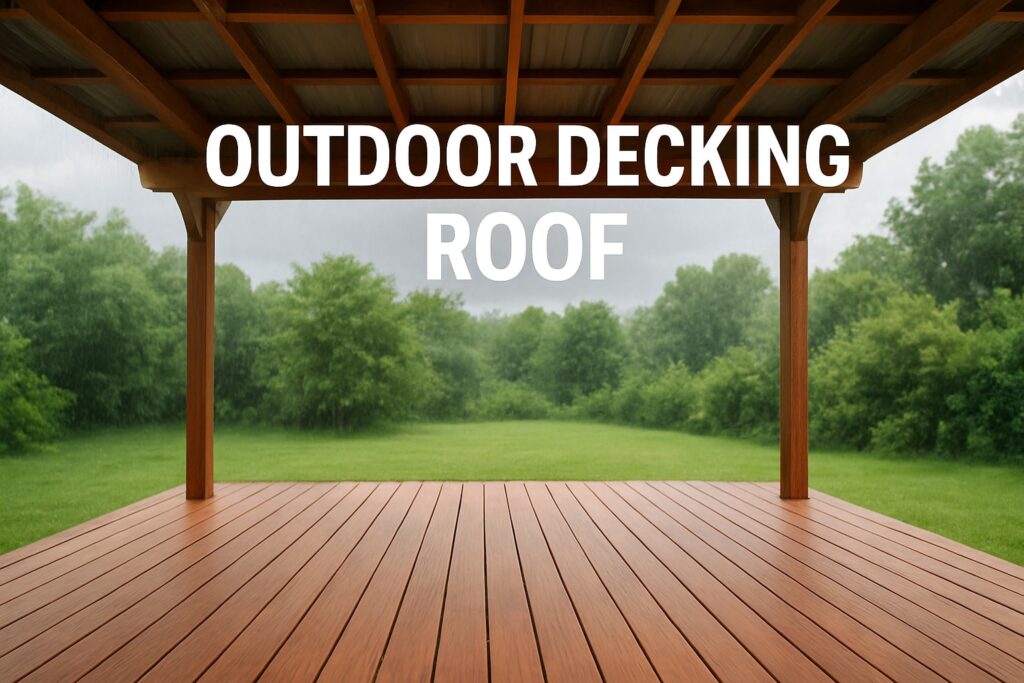Imagine stepping outside into a sleek, comfortable retreat, protected from the elements and ready for any season. An outdoor decking roof can transform your patio, balcony, or rooftop into a functional extension of your home, blending style with year-round usability.
In this guide, you will discover expert advice, innovative ideas, and the latest trends to help you design the perfect outdoor decking roof for 2025. We will explore the benefits, best materials, modern design inspirations, installation steps, maintenance strategies, and smart ways to maximize your investment.
Ready to create your ideal outdoor space? Let’s get started.
Understanding Outdoor Decking Roofs: Benefits and Considerations
Transforming your outdoor living area starts with understanding the outdoor decking roof and what sets it apart. Whether you have a sprawling backyard or a compact urban balcony, these systems redefine how you use exterior spaces throughout the year.

What is an Outdoor Decking Roof?
An outdoor decking roof is a protective structure built over a deck, patio, balcony, or rooftop to shield the space from the elements. Unlike pergolas, which offer partial shade, or awnings that provide retractable cover, an outdoor decking roof is designed for full weather protection and durability.
These roofs can be integrated seamlessly with existing outdoor surfaces, whether on a ground-level deck, an elevated patio, or a high-rise rooftop. Some systems are permanent, while others are modular and can be adapted for different layouts and uses. The right outdoor decking roof not only covers your space but also elevates its function and appearance.
Key Benefits of Decking Roofs
Choosing an outdoor decking roof brings a range of advantages that go beyond simple shelter. Some of the most compelling benefits include:
- Year-round usability: Enjoy your deck or patio in any season, protected from rain, snow, and harsh sunlight.
- Enhanced property value: According to Remodeling Magazine, adding a quality decking roof can boost your home's value by up to 10 percent.
- Improved comfort and privacy: Shield your space from prying eyes and create a more comfortable microclimate.
- Expanded living area: Use your outdoor space for dining, entertaining, or relaxing, no matter the weather.
These benefits make the outdoor decking roof an investment in both lifestyle and long-term value. Homeowners increasingly see covered outdoor areas as essential for modern living.
Important Considerations Before You Begin
Before starting an outdoor decking roof project, it is critical to address a few key factors:
- Local building codes and permits: Always check regulations and secure the proper permissions, especially in condos or HOAs.
- Load-bearing capacity: Rooftop or balcony installations must meet structural requirements to ensure safety.
- Exposure analysis: Assess how much sun, wind, and rain your space receives to select suitable materials and designs.
- Drainage and waterproofing: Plan effective water management to prevent leaks and structural damage.
Taking these steps early helps avoid costly mistakes and ensures your outdoor decking roof meets both safety and design standards.
Common Challenges and How to Overcome Them
Every project has its obstacles, but smart solutions can make a big difference with your outdoor decking roof:
- Limited space: Urban balconies and small patios require compact, modular systems that maximize usable area.
- Roof slope and uneven surfaces: Adjustable pedestal supports or floating systems accommodate sloped or irregular roofs.
- Maintenance accessibility: Design for easy cleaning and repairs to extend the lifespan of your decking roof.
- Harsh climates: Choose materials rated for extreme weather, like Canadian winters.
For example, a Toronto condo used a modular decking roof system and increased its usable outdoor space by 40 percent. According to Houzz (2023), 68 percent of urban homeowners now seek covered outdoor areas for year-round enjoyment. If you are considering flexible solutions, modular decking roof systems are ideal for overcoming space and installation challenges while maintaining code compliance.
Top Decking Roof Materials and Systems for 2025
Selecting the right materials and systems is crucial for creating a durable, stylish, and low-maintenance outdoor decking roof. The choices you make today will define the comfort, longevity, and value of your space for years to come.

Wood, Composite, and PVC Decking Roofs
Traditional wood remains a popular choice for outdoor decking roof systems due to its natural beauty and versatility. Cedar, ipe, and thermally modified woods offer rich tones and resistance to decay. However, regular sealing is essential to prevent weathering.
Composite and PVC options provide fade resistance and low maintenance, making them ideal for busy homeowners. These materials mimic the look of wood without the need for frequent upkeep. For more on installation and care, consult this Composite deck tiles guide.
Both wood and composite systems can be tailored to suit rooftop or balcony applications, ensuring your outdoor decking roof stands up to varied climates.
Metal and Aluminum Roofing Systems
Metal and aluminum have emerged as leading materials for outdoor decking roof projects in 2025. These systems are lightweight, corrosion-resistant, and can last up to 50 years with proper maintenance.
Modern finishes and color options allow seamless integration with contemporary architecture. Aluminum roofs, in particular, are well-suited to urban environments where weight limitations are a concern.
Metal systems can also accommodate solar panels or green roofing features, offering additional sustainability benefits for your outdoor decking roof.
Glass and Polycarbonate Roof Panels
Glass and polycarbonate panels are perfect for maximizing daylight while providing year-round protection. These materials block harmful UV rays and offer strong impact resistance, making them a popular choice for an outdoor decking roof in both residential and commercial settings.
Tinted or frosted options add privacy, while retractable systems allow flexible light control. Insulated panels help regulate temperature and improve energy efficiency.
With their sleek appearance, glass and polycarbonate roofs are a hallmark of upscale outdoor decking roof designs.
Fabric and Louvered Roof Systems
Fabric and louvered systems provide exceptional versatility for an outdoor decking roof. Motorized or manual louvers allow you to customize shade and ventilation with ease.
Waterproof, fire-retardant fabrics ensure all-weather comfort and safety. Permanent louvered roofs offer robust protection, while retractable awnings deliver flexibility for changing conditions.
These solutions are ideal for patios, terraces, and balconies where adaptability is key to extending the usability of your outdoor decking roof.
Modular and Floating Decking Roof Solutions
Modular and floating systems are rapidly gaining popularity for outdoor decking roof installations, especially in condos and rental properties. These systems use adjustable pedestals and lightweight tiles, enabling quick installation with minimal impact on existing structures.
Floating pedestal solutions are particularly well-suited for rooftop projects, as they protect underlying membranes and allow for easy maintenance access. This approach creates a level, stable surface even on uneven rooftops, expanding the possibilities for any outdoor decking roof.
Sustainability and Eco-Friendly Materials
Eco-conscious homeowners are increasingly seeking sustainable choices for their outdoor decking roof. Materials with recycled content, FSC-certified wood, and low-VOC finishes are now mainstream.
Solar-integrated roofing and rainwater harvesting compatibility further enhance green credentials. According to NAHB, 54% of homeowners now prefer eco-friendly decking materials, reflecting a significant shift in outdoor decking roof trends.
Investing in sustainable systems not only reduces environmental impact but can also increase property value and appeal.
Cost Comparison and Lifespan Data
Evaluating costs and lifespan is essential when planning your outdoor decking roof. The table below summarizes average costs and expected longevity for popular materials and systems:
| Material/System | Avg. Cost (per sq. ft.) | Expected Lifespan | Maintenance Level |
|---|---|---|---|
| Wood (Cedar/Ipe) | $20–$40 | 15–25 years | High |
| Composite/PVC | $25–$50 | 25–30 years | Low |
| Metal/Aluminum | $30–$60 | 40–50 years | Low |
| Glass/Polycarbonate | $40–$80 | 20–30 years | Medium |
| Fabric/Louvered | $15–$45 | 10–20 years | Medium |
| Modular/Floating | $30–$55 | 20–25 years | Low |
Selecting the right balance of upfront investment and maintenance needs ensures your outdoor decking roof delivers value and lasting enjoyment.
Design Trends and Creative Ideas for Outdoor Decking Roofs in 2025
Transforming your outdoor decking roof into a contemporary retreat starts with understanding the latest design trends. In 2025, homeowners and designers are embracing innovation, sustainability, and technology to maximize both style and function. Whether you have a spacious backyard or an urban balcony, these creative ideas will help you create an inspiring, functional space. For more inspiration and planning insights, explore Planning outdoor floor design.

Minimalist and Modern Aesthetics
Minimalism continues to shape outdoor decking roof designs in 2025. Clean lines, neutral colors, and uncluttered layouts create a sense of calm and sophistication. Frameless glass railings and concealed fasteners enhance the seamless flow between indoor and outdoor spaces. Hidden drainage systems maintain the sleek appearance without sacrificing function.
A minimalist outdoor decking roof often features integrated lighting and subtle textures. These choices not only boost curb appeal but also provide a timeless foundation for evolving tastes.
Multi-Functional and Modular Spaces
Modern outdoor decking roof trends prioritize flexibility and adaptability. Homeowners are incorporating convertible roofs, retractable walls, and built-in seating to maximize space and usability. Multi-functional features like outdoor kitchens, fire pits, and smart lighting transform decks into true extensions of the home.
Modular systems allow for easy reconfiguration, making it simple to adapt your outdoor decking roof for dining, entertaining, or relaxing. This approach is especially valuable for growing families or those who love to host gatherings.
Biophilic and Nature-Inspired Designs
Bringing nature into your outdoor decking roof is a key trend. Biophilic elements such as living green roofs, planters, and vertical gardens enhance well-being and create a tranquil environment. Designers are using organic shapes and natural materials like wood and stone to blur the lines between built and natural spaces.
Incorporating biophilic design not only adds visual interest but also improves air quality and biodiversity. Your outdoor decking roof can become a private oasis that supports both relaxation and sustainability.
Tech Integration and Smart Features
Technology is rapidly transforming the outdoor decking roof experience. Automated louver systems, app-controlled lighting, and built-in heating provide convenience and comfort in any season. Solar-powered features and weather sensors help optimize energy use and adapt to changing conditions.
Smart integration also extends to entertainment, with wireless speakers, outdoor TVs, and programmable ambiance settings. These enhancements ensure your outdoor decking roof is as functional as it is stylish.
Urban and Small-Space Solutions
For city dwellers, maximizing limited space is essential. 2025 trends highlight space-saving outdoor decking roof designs, including foldable furniture and multi-use storage solutions. Modular and floating systems are ideal for balconies and compact patios, offering flexibility without permanent alterations.
Space-efficient layouts, vertical gardens, and light-colored finishes help small areas feel open and inviting. Even the smallest outdoor decking roof can deliver year-round comfort and visual appeal.
Case Examples and Visual Inspiration
A standout example is a downtown rooftop terrace featuring a retractable glass roof and integrated LED lighting, blending modern design with all-weather usability. According to Builder Magazine (2024), 72% of new luxury condos in major cities now include covered outdoor spaces, reflecting the growing demand for functional, stylish outdoor decking roof solutions. These trendsetting projects offer inspiration for homeowners seeking to elevate their own outdoor environments.
Step-by-Step Guide: Planning and Installing a Decking Roof
Transforming your outdoor space with an outdoor decking roof requires precise planning and attention to detail. By following a clear, step-by-step process, you can ensure your new structure is safe, stylish, and built to last. Whether you are upgrading a rooftop, patio, or balcony, this guide will help you navigate every stage of your project.

Step 1: Assess Your Space and Needs
Begin by evaluating your outdoor area. Measure the dimensions of your deck, patio, or balcony to determine the available footprint for your outdoor decking roof. Consider how you plan to use the space: Do you want shade, rain protection, privacy, or year-round usability?
Analyze factors such as sun exposure, prevailing winds, and nearby structures. This assessment will inform your material choices and design preferences. If your goal is to create a space for dining or entertaining, think about traffic flow and furniture placement. For rooftop decks, check the load-bearing capacity to ensure your outdoor decking roof will be supported safely.
Step 2: Check Regulations and Obtain Permits
Before starting construction, research local building codes and permit requirements. Many municipalities require permits for any structural addition, including an outdoor decking roof. If you live in a condo or belong to a homeowners association, review their rules for exterior modifications.
Consult with a structural engineer or architect if you are unsure about code compliance, especially for rooftop or multi-level installations. Permits help ensure your project meets safety standards and avoids costly legal issues. Fire safety regulations and setback requirements may also impact your design, so factor these into your planning process.
Step 3: Choose the Right Materials and System
Select materials that align with your climate, aesthetic preferences, and maintenance expectations. Wood, composite, PVC, metal, and glass are all popular choices for an outdoor decking roof. Each material offers unique benefits: wood provides warmth, composite and PVC offer low maintenance, and metal stands out for its durability.
For a modern, long-lasting result, consider porcelain decking options. Porcelain tiles are highly durable, fade-resistant, and ideal for Canadian climates. Modular pedestal systems can support these tiles, making them suitable for rooftops and balconies. Compare warranties, color options, and eco-friendly features when making your final decision.
Step 4: Design Your Decking Roof Layout
A thoughtful design maximizes function and visual appeal. Plan the roof slope to ensure proper drainage, preventing water buildup and leaks. Integrate the outdoor decking roof seamlessly with your existing deck or patio, considering railing heights and transitions.
Map out locations for lighting, electrical outlets, and accessories such as planters or privacy screens. Use design software or sketches to visualize the space. If your area is compact, opt for space-saving layouts and multi-use elements. This step ensures your outdoor decking roof meets both practical and aesthetic goals.
Step 5: Prepare the Site and Foundation
Preparation is key to a successful installation. Clean and inspect your existing deck or rooftop surface, removing debris and checking for damage. Address any repairs before proceeding to safeguard the underlying structure.
Install supports, framing, or pedestals as required by your chosen system. For rooftop projects, floating pedestal systems are popular because they minimize impact on the waterproof membrane and allow for easy leveling over uneven surfaces. Learn more about the benefits of Pedestal Decking Systems for rooftop applications. Proper preparation ensures your outdoor decking roof is stable and long-lasting.
Step 6: Install the Decking Roof System
Follow manufacturer instructions closely during installation. Assemble framing, attach roof panels or tiles, and secure all fasteners. Pay special attention to waterproofing at joints and edges to prevent leaks.
If you are using modular or floating systems, make sure each component is correctly aligned and level. Double-check connections as you go. For glass or polycarbonate roofs, use the recommended sealants and gaskets. Taking the time to install your outdoor decking roof properly will save you maintenance headaches later.
Step 7: Add Finishing Touches and Accessories
Once the main structure is in place, personalize your outdoor decking roof with accessories. Install lighting for evening ambiance, and add planters or vertical gardens to introduce greenery. Privacy screens can shield you from wind and neighbors, while integrated seating maximizes usable space.
Test the drainage system to ensure water flows away efficiently. Arrange furniture and décor to reflect your intended use of the space. A well-appointed outdoor decking roof becomes an inviting retreat for relaxation or entertaining.
Professional vs. DIY Installation
Deciding between professional and DIY installation depends on your skill level, timeline, and budget. Professionals bring expertise, faster completion, and often include warranties. DIY installation can save on labor costs but requires careful planning, access to tools, and a willingness to learn.
Consider the complexity of your outdoor decking roof system. Modular and pedestal-based designs are more DIY-friendly, while custom-built or heavy structures may require professional handling. Review average costs and timelines before making your choice.
Safety Tips and Common Pitfalls to Avoid
Safety is paramount in any construction project. Avoid overloading decks or rooftops by verifying structural limits before installing an outdoor decking roof. Use non-slip surfaces to reduce accident risks, especially in wet or icy conditions.
Ensure all waterproofing measures are thorough to prevent leaks and long-term damage. Maintain accessibility for future inspections and cleaning. For example, using floating porcelain pavers on a balcony protects the underlying membrane and simplifies maintenance. By anticipating challenges, you can enjoy your outdoor decking roof for years to come.
Maintenance, Upkeep, and Longevity of Decking Roofs
A well-maintained outdoor decking roof stands the test of time, offering comfort and protection for years. Proper care not only preserves its appearance but also ensures safety and maximizes your investment.
Routine Cleaning and Seasonal Care
Routine cleaning is the cornerstone of outdoor decking roof maintenance. For wood, sweep debris frequently and wash with a mild soap solution twice a year. Composite and metal systems only need occasional rinsing, while glass and polycarbonate panels benefit from gentle, streak-free cleaners.
Preventing mold and mildew is crucial, especially in damp climates. Promptly remove fallen leaves and keep drainage paths clear. In snowy regions, use a plastic shovel for snow and ice removal to avoid damaging the surface.
Choosing eco-friendly materials makes upkeep easier and more sustainable. Learn more about Sustainable Decking Materials that require less maintenance and have a lower environmental impact.
Inspection and Repair Tips
Regular inspections help catch problems early and extend the life of your outdoor decking roof. Once a year, check for leaks, loose fasteners, and structural wear. Examine joints, flashing, and seams for signs of water intrusion or corrosion.
Look for cracks, warping, or discoloration, especially on wooden or composite roofs. Address minor repairs immediately to prevent larger issues. If you spot significant damage or feel unsure about repairs, contact a professional to ensure safety and code compliance.
Extending Lifespan and Maximizing Value
Protective measures can significantly increase the lifespan of your outdoor decking roof. Apply sealants or finishes to wood surfaces as recommended by the manufacturer. For composite and metal systems, occasional cleaning and prompt removal of debris are often enough.
Upgrade accessories over time, such as adding planters, new lighting, or smart controls, to keep your space modern and functional. Investing in quality materials and regular care helps maintain property value and ensures your roof remains a standout feature.
Warranty and Insurance Considerations
Understanding warranty terms is vital for any outdoor decking roof. Most manufacturers offer warranties covering defects or premature wear, but regular maintenance is often required to keep coverage valid.
Add your decking roof to your homeowner insurance policy. This protects against accidental damage and weather-related events, giving you peace of mind. Review policy details to confirm what is covered and what documentation is needed for claims.
Cost-Saving Maintenance Strategies
Balancing DIY and professional maintenance can save money over time. Cleaning, minor repairs, and accessory upgrades are often manageable for homeowners. However, annual inspections or complex repairs may warrant professional attention.
Preventative care, such as keeping gutters clear and addressing small issues promptly, helps avoid costly replacements. Opting for materials that require less upkeep reduces long-term expenses and makes maintenance more manageable for any outdoor decking roof.
Data and Insights
Proper maintenance directly impacts the longevity of your outdoor decking roof. According to HomeAdvisor, well-maintained systems can last 25 to 50 years, depending on the material. For example, composite roof tiles have demonstrated more than 20 years of durability with routine care.
A rooftop deck in Ontario maintained with regular cleaning and inspections has retained its like-new appearance after eight years. Consistent attention ensures your investment delivers comfort, safety, and value year after year.







